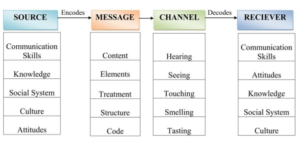4. Berlo’s S-M-C-R Model
While the Aristotle model of communication puts the speaker in the central position and suggests that the speaker is the one who drives the entire communication, the Berlo’s model of communication takes into account the emotional aspect of the message.Berlo’s Model has mainly, four components to describe the communication process. They are sender, message, channel and receiver. Each of the component is affected by many factors. Berlo’s model of communication operates on the SMCR model.
In the SMCR model
S– Stands for Source
Sender is the source of the message or the person who originates the message. The person or source sends the message to the receiver. The following are the factor related to sender and is also the same in the case of receiver:
• Communication Skills
It is the individual’s skill to communicate i.e. ability to read, write, speak, listen etc. If the sender has good communication skills, the message will be communicated better than if the sender’s communication skills are not good. Similarly, if the receiver can not grasp the message, then the communication will not be effective. Communication skills include the skills to speak, present, read, write, listening, etc.
• Attitude
The attitude of the sender and the receiver creates the effect of the message. The person’s attitude towards self, the receiver and the environment changes the meaning and effect of the message.
• Knowledge
Familiarity with the subject of the message makes the communicated message have its effect more. Knowledge on the subject matter makes the communicator send the message effectively.
• Social Systems:
Values, beliefs, laws, rules, religion and many other social factors affect the sender’s way of communicating the message. It creates difference in the generation of message. Place and situation also fall under social systems.
• Culture
Cultural differences make messages different. A person from one culture might find something offensive which is very much accepted in another culture.
M – Message
A message is the substance that is being sent by the sender to the receiver. It might be in the form of voice, audio, text, video or other media. The key factors affecting the message are
• Content
A thought has to be put into words and content has to be prepared. Content is actually the matter or the script of the conversation. It is in simpler words, the backbone of any communication.
• Elements
Elements are the non verbal things that tag along with the content like gestures, postures, facial expressions, body signs, language, etc.
• Treatment
Treatment is the way in which the message is conveyed to the receiver. Treatment also effects the feedback of the receiver.
• Structure
A message cannot be expressed in one go. It has to be properly structured in order to convey the message in the most desired form
- Code
Code is the form in which the message is sent. It might be in the form of language, text, video, etc.
C – Channel
Channel actually refers to the medium how the information flows from the sender to the receiver. In mass communication and other forms of communication, technical machines might be used as a channel like telephone, internet, etc. But in general communication, all the five senses are the channels which help human beings to communicate with each
• Hearing- We receive the message through hearing.
• Seeing- We perceive through seeing. We also get non-verbal messages by seeing.
• Touching- Many of the non-verbal communication happens from touching like holding hands.
• Smelling- We collect information from smelling.
• Tasting- Taste also provides the information to be sent as a message.
R – Receiver
Receiver is the person who gets the message sent in the process. This model believes that the thinking pattern and all other factors mentioned above must be in sync to that of the sender for the communication to be effective. The message might not have the same effect as intended if the receiver and sender are not similar. The receiver must also have a very good listening skill. Other factors are similar to that of the sender.
• Communication skills
• Attitudes
• Knowledge
• Social Systems
• Culture
Criticism
• There is no concept of feedback, so the effect is not considered.
• The model does not mention about barriers to communication. There is no room for noise.
• It is a linear model of communication, there is no two way communication.
• Main drawback of the model is that the model omits the usage of sixth sense as a channel which is actually a gift to the human beings (thinking, understanding, analyzing etc).
• Both of the people must be similar according to all the factors mentioned above.

